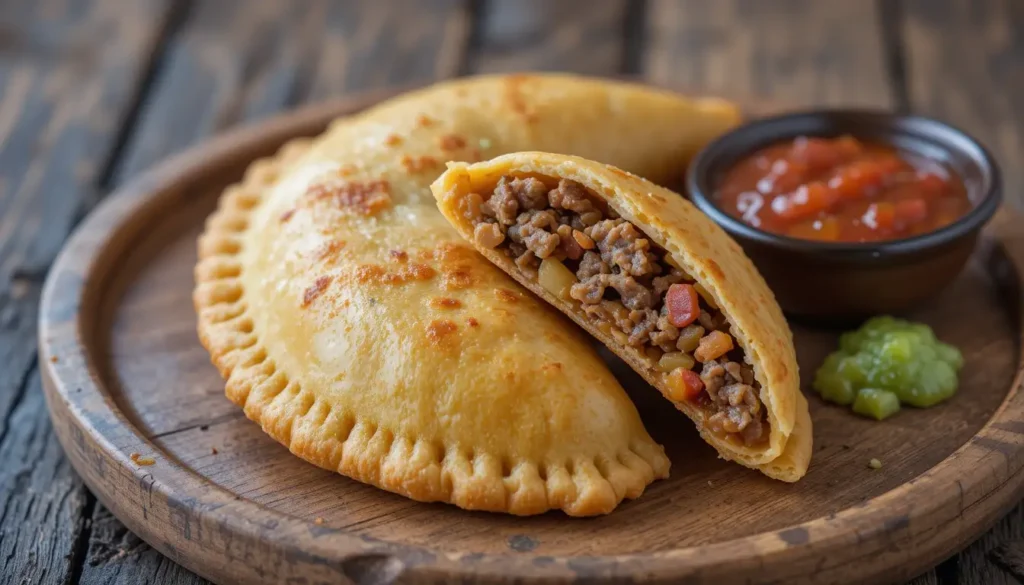Empanadas are beloved all over Latin America. Whether as a quick snack, hearty breakfast, or late-night treat, these golden pockets of deliciousness bring joy to millions. But when you narrow the focus to Colombian and Venezuelan empanadas, it opens up a world of fascinating differences. What sets them apart? Is it the dough, the fillings, or the cooking techniques? Let’s take a tasty journey to uncover what is the difference between Colombian and Venezuelan empanadas while celebrating the unique flavors and traditions of both.
Table of Contents
Colombian and Venezuelan Empanadas
Empanadas are more than just food—they are cultural icons. For generations, they’ve served as comfort food, street snacks, and family traditions passed down in kitchens across Latin America. Both Colombian empanadas and Venezuelan empanadas share the same concept: a dough pocket stuffed with savory fillings. Yet, as similar as they may seem, the nuances between the two make each style of empanada truly unique.
In Colombia, empanadas are often crispy, golden, and deep-fried, while Venezuelan empanadas offer a more diverse cooking style. But there’s much more to it than just frying vs. baking.
Understanding Empanadas: A Culinary Staple in Latin America
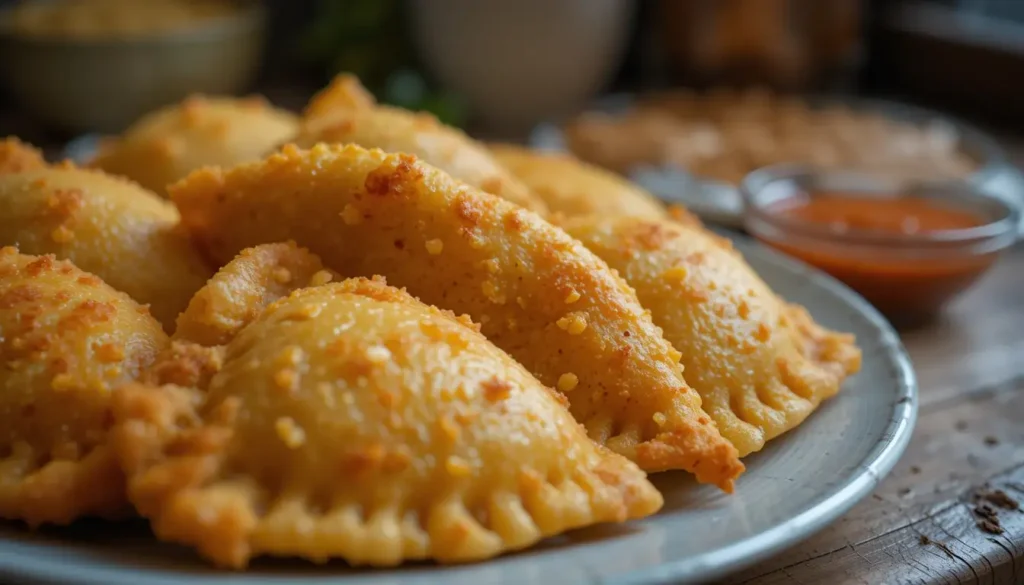
Empanadas trace their roots to Spanish colonial times when explorers brought the idea of pastry pockets to South America. Over time, local ingredients and cultural influences gave rise to various versions of empanadas across the region.
In essence, an empanada is a folded dough pocket filled with ingredients like meat, cheese, or vegetables. Each country has added its unique twist, creating something special and flavorful. For Colombians and Venezuelans, empanadas are a symbol of community. From street vendors selling them for breakfast to family gatherings where recipes are closely guarded, empanadas hold a special place in both cultures.
Colombian empanadas are made using cornmeal, resulting in a rustic and hearty texture, whereas Venezuelan empanadas feature a softer, thinner dough. For a deeper dive into Venezuelan empanadas, check out this article on their cultural roots and recipes.
Colombian Empanadas: Key Characteristics
Ingredients Used in Colombian Empanadas
Colombian empanadas are known for their crispy texture and deep-fried goodness. Unlike traditional wheat flour-based empanadas, Colombian dough relies heavily on cornmeal, specifically yellow precooked cornmeal (known as masarepa). This gives the dough a distinct yellow hue and a grainier texture, adding to the crunch factor.
The fillings are simple yet flavorful. The most common ingredients include:
- Shredded beef or ground meat
- Cooked potatoes (often mashed for creaminess)
- Onions and garlic for added aroma
- Spices like cumin, paprika, and salt for a bold flavor
Colombians value simplicity in their empanadas, often using just a handful of ingredients to let the flavor shine through.
Cooking Techniques and Preparation
When it comes to preparation, Colombian empanadas are typically deep-fried. Frying gives them that unmistakable crunchy shell, which crackles with every bite. Here’s a basic breakdown of the process:
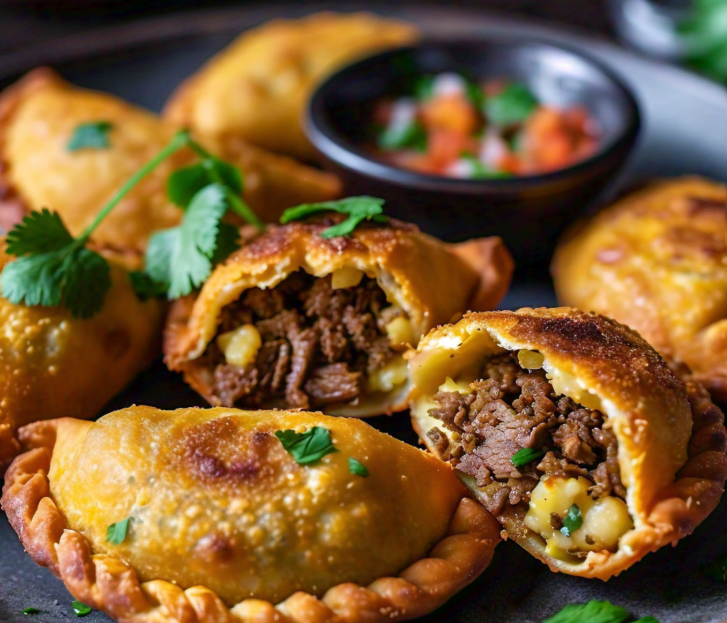
- Prepare the dough: Combine cornmeal with water, salt, and a touch of oil until it forms a soft, pliable dough.
- Fill and shape: Place the dough on plastic wrap, flatten it into a circle, add the filling, and fold it into a crescent shape.
- Fry to perfection: Drop the empanadas into hot oil until golden and crispy.
The frying technique ensures the dough forms a sturdy shell, protecting the filling inside while enhancing flavor and texture.
Common Fillings in Colombian Empanadas
The most popular filling for Colombian empanadas combines beef and potato, seasoned with onions, garlic, and cumin. However, there are regional variations to suit different tastes:
- Pollo (chicken): Shredded chicken cooked with spices and onions.
- Queso (cheese): A simpler option with melted cheese inside the crunchy dough.
- Vegetarian options: Potatoes, beans, and mixed vegetables for a lighter version.
No matter the filling, Colombian empanadas often come paired with aji, a spicy salsa made with cilantro, onions, tomatoes, lime, and chili peppers. This tangy sauce elevates the flavor and adds a zesty kick.
Venezuelan Empanadas: Key Characteristics
Ingredients Used in Venezuelan Empanadas
Unlike their Colombian counterparts, Venezuelan empanadas use corn flour but often result in a softer texture. The dough still features precooked cornmeal, but the consistency is smoother, almost reminiscent of arepa dough.
Venezuelan empanadas showcase a wider range of fillings, offering something for everyone. Popular ingredients include:
- Shredded beef or chicken
- Cheese (especially white, salty cheese)
- Fish (such as cazón, a popular shark meat filling)
- Black beans and plantains for a sweeter twist
Venezuelan empanadas celebrate variety and creativity, often blending salty, sweet, and savory flavors into one delicious bite.
Cooking Methods and Variations
While Colombian empanadas are almost exclusively fried, Venezuelan empanadas offer more versatility. They can be fried or baked, depending on regional preferences or dietary choices.
Here’s a quick comparison:
- Fried Venezuelan empanadas: Crispy and golden, similar to Colombian ones but often less crunchy due to the softer dough.
- Baked Venezuelan empanadas: A healthier alternative, resulting in a lighter texture while still preserving the flavor.
This flexibility makes Venezuelan empanadas appealing to a broader audience. Whether you prefer a crispy indulgence or a healthier baked version, Venezuelan empanadas cater to all preferences.

Popular Fillings in Venezuelan Empanadas
One of the standout features of Venezuelan empanadas is the diversity of fillings. While meat and cheese dominate, other options provide a delightful twist:
- Pabellón filling: Inspired by Venezuela’s national dish, this filling combines black beans, shredded beef, sweet plantains, and salty cheese.
- Cazón (shark meat): A coastal specialty that highlights Venezuela’s rich seafood culture.
- Domino: A vegetarian favorite featuring black beans and cheese.
The fillings often reflect Venezuela’s rich culinary heritage, blending bold flavors with unique local ingredients. To top it off, Venezuelan empanadas are often served with guasacaca, a creamy avocado-based sauce similar to guacamole.
Key Differences Between Colombian and Venezuelan Empanadas
Now that we’ve explored the basics of both Colombian and Venezuelan empanadas, it’s time to get into the nitty-gritty. Despite sharing common roots and ingredients, their differences are where the magic happens.
Dough Composition and Texture
One of the most noticeable differences lies in the dough.
- Colombian empanada dough is made from yellow cornmeal (masarepa), giving it a coarse, grainy texture and vibrant yellow hue. This results in a crispier and crunchier bite. The dough itself is quite thin, which makes it the perfect vessel for the savory fillings inside.
- Venezuelan empanada dough, on the other hand, uses a smoother white or yellow corn flour, leading to a softer, chewier texture. The dough is often slightly thicker, which makes it better suited for both frying and baking.
In short, Colombian empanadas boast a crunchier shell, while Venezuelan empanadas strike a balance between soft and crisp, depending on how they’re prepared.
Cooking Style: Fried vs. Baked
Cooking techniques play a pivotal role in distinguishing these two styles.
- Colombian empanadas are almost always deep-fried to achieve their signature crispy exterior. The golden-brown crust is essential to their flavor profile and visual appeal.
- Venezuelan empanadas, on the other hand, offer more options. While frying remains popular, baking is also common, especially for those looking for a lighter, healthier alternative. This versatility allows Venezuelan empanadas to cater to different dietary preferences without sacrificing flavor.
So, if you love that unmistakable crunch, Colombian empanadas are your go-to. If you’re after something softer or a baked option, Venezuelan empanadas might win you over.
Fillings: Meat, Cheese, and Beyond
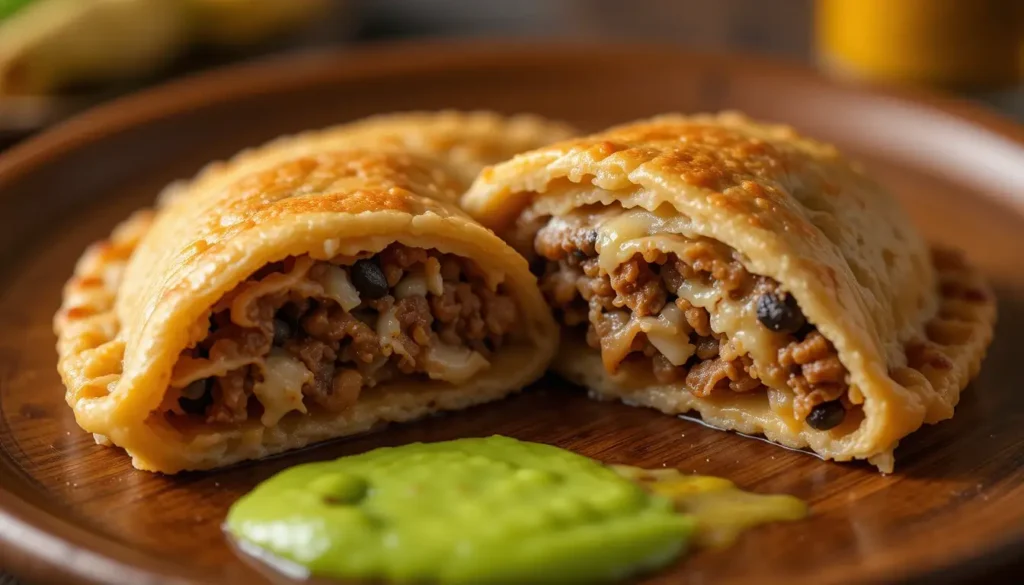
Fillings are where both Colombian and Venezuelan empanadas truly shine, but they differ in style and variety.
- Colombian empanadas tend to favor simpler, hearty fillings. The classic combination of shredded beef and potato is the star, with occasional additions of chicken or cheese. The focus here is on creating a satisfying, savory bite without overcomplicating the flavor.
- Venezuelan empanadas embrace variety and creativity. Fillings like cazón (shark meat), pabellón (a mix of black beans, beef, plantains, and cheese), and the ever-popular queso blanco (white cheese) reflect the country’s diverse culinary influences. Sweet and savory combinations are also more common in Venezuelan empanadas, offering a unique twist on the traditional concept.
If you’re a purist who loves classic, no-frills fillings, Colombian empanadas are perfect. But if you enjoy exploring bold and unexpected flavors, Venezuelan empanadas are the way to go.
Regional Flavors and Spices
The seasonings used in each style of empanada also contribute to their distinct flavor profiles.
- Colombian empanadas rely heavily on spices like cumin, paprika, and garlic, creating a warm, savory taste. While the seasoning is subtle, it complements the rich fillings and crispy texture.
- Venezuelan empanadas often incorporate bolder flavors, with hints of sweetness and saltiness in their fillings. Ingredients like plantains, black beans, and seafood reflect the country’s diverse regional influences, from the coast to the mountains.
In essence, Colombian empanadas lean toward savory simplicity, while Venezuelan empanadas embrace a mix of bold and complex flavors.
Why Are Empanadas Culturally Significant in Colombia and Venezuela?
Empanadas are far more than just a delicious snack in both Colombia and Venezuela. They carry deep cultural significance, symbolizing family, tradition, and a shared love for food.
In Colombia, empanadas are a staple of daily life. You’ll find them at bustling street corners, markets, and homes, especially during breakfast or mid-afternoon snacks. They bring people together, offering a quick, affordable, and satisfying meal. Empanadas also play a key role in Colombian celebrations and gatherings, where sharing food is a gesture of love and hospitality.
For Venezuelans, empanadas are equally cherished. They’re a versatile food that bridges the gap between regions, from the coastal areas where seafood reigns supreme to the Andean mountains with their hearty meat and cheese fillings. Venezuelan families often enjoy empanadas during holidays, weekends, or casual meals, creating lasting memories over shared meals.
Both countries view empanadas as a representation of their culinary heritage and cultural pride. They’re not just food—they’re a connection to the past and a celebration of local ingredients and traditions.
Solutions to Overcome Empanada-Making Challenges
Don’t worry—these problems have solutions! Here are some tips to ensure your empanadas turn out perfectly every time:
Tips for Perfect Dough Preparation
- Measure carefully: Follow the exact ratio of cornmeal to water when making the dough. Adjust slightly if needed, but aim for a soft, pliable texture.
- Rest the dough: Letting the dough rest for 10-15 minutes makes it easier to work with and prevents cracks.
- Plastic wrap trick: Roll and shape the dough using plastic wrap to avoid sticking or tearing.
Cooking Tricks to Prevent Breakage
- Check your oil temperature: Ensure the oil is hot (around 350°F or 175°C) before frying to quickly seal the dough.
- Avoid overfilling: Use just enough filling to avoid putting stress on the dough.
- Seal it well: Press the edges firmly with a fork to prevent leaks.
Achieving Balance Between Flavor and Texture
- Experiment with different fillings while keeping moisture under control. Avoid overly wet ingredients that can compromise the dough.
- For baked Venezuelan empanadas, brush the tops with oil or egg wash to achieve a golden, crispy finish.
With these tips, anyone can master the art of making empanadas, whether Colombian or Venezuelan!
Which Empanada Should You Try: Colombian or Venezuelan?
So, with all this talk about crunchy, flavorful Colombian empanadas and the diverse, hearty Venezuelan empanadas, the big question remains: which one should you try? Well, it depends on what you’re looking for!
Choosing Based on Flavor Preferences
If you’re a fan of bold, savory simplicity with a crispy bite, Colombian empanadas are for you. Their cornmeal-based dough, combined with fillings like beef and potatoes, delivers a hearty and satisfying snack. The aji salsa adds a burst of freshness and spice that perfectly complements the rich flavors.
On the other hand, if you enjoy variety and love exploring flavors that blend salty, sweet, and savory notes, Venezuelan empanadas are an adventure worth taking. From cheese and beans to seafood and the iconic pabellón filling, Venezuelan empanadas cater to more diverse tastes. Plus, you can enjoy them fried for indulgence or baked for a lighter option.
Understanding the Occasion and Regional Influence
Are you looking for a quick street food snack that’s easy to grab and eat on the go? Colombian empanadas are the answer. They are smaller, portable, and perfectly crunchy, making them ideal for a fast, filling bite.
For a more substantial meal or something you can enjoy at home, Venezuelan empanadas offer larger portions and a more filling experience. Their versatility in fillings means you can customize them based on your cravings—whether it’s something traditional like shredded beef or a twist with plantains and cheese.
If you’re hosting a gathering, why not offer both? Colombian empanadas can serve as crunchy appetizers, while Venezuelan empanadas can shine as the main course with their hearty and flavorful fillings. It’s a win-win situation!
The Growing Popularity of Empanadas Worldwide
Empanadas have come a long way from their humble origins in Latin America. Today, they’ve made their mark across the globe, becoming a beloved snack in many cultures. From food trucks in New York City to fine dining establishments in Europe, empanadas are celebrated for their versatility, flavor, and convenience.
Why Empanadas Appeal to a Global Audience
The universal appeal of empanadas lies in their simplicity. They are easy to eat, portable, and can be adapted to suit any cuisine. Whether you fill them with traditional ingredients like beef and potatoes or experiment with international flavors like curry, cheese, or vegetables, empanadas are endlessly customizable.
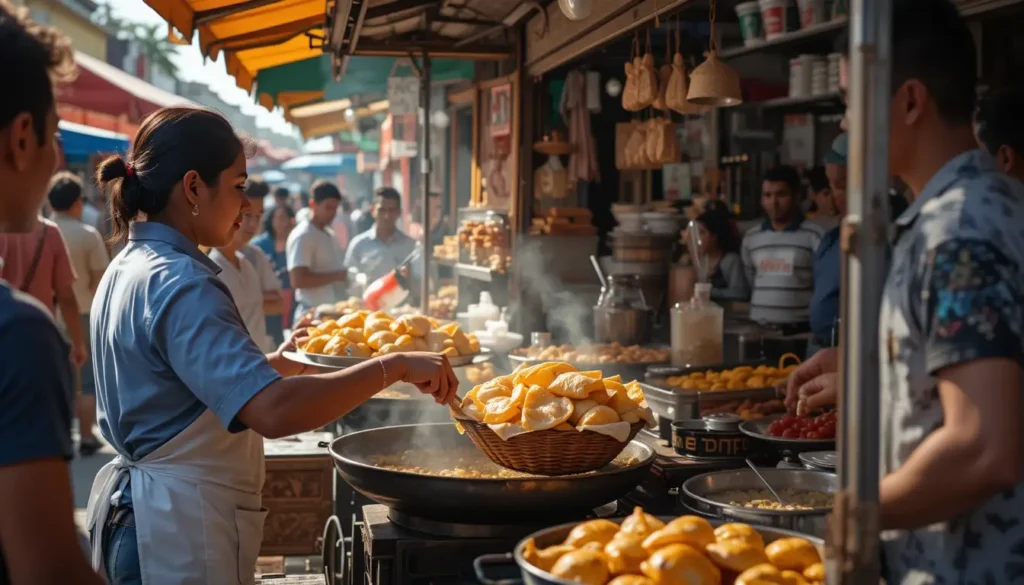
- Colombian empanadas are loved for their crispy texture and hearty fillings. Their unique cornmeal dough sets them apart, offering something different from flour-based pastries like samosas or turnovers.
- Venezuelan empanadas, with their softer dough and diverse fillings, appeal to those who enjoy rich and complex flavors.
Empanadas also bring people together. Whether you’re enjoying them as street food in Bogotá, snacking on one during a beach day in Caracas, or making them at home with family, they create a shared experience that transcends borders.
Fusion Empanadas: Blending Cultures and Flavors
As empanadas gain popularity worldwide, chefs and food enthusiasts have started experimenting with fusion flavors. Think BBQ pulled pork empanadas, spicy Thai chicken empanadas, or even pizza-stuffed empanadas. While these creative takes on the classic empanada are exciting, they still pay homage to the original versions from Colombia and Venezuela.
This global love for empanadas highlights their adaptability and timeless appeal. No matter where you are, a good empanada is always a welcome treat.
FAQs
What makes Colombian empanadas unique?
Colombian empanadas stand out because of their crispy, golden shell made with yellow cornmeal (masarepa). Their classic filling of beef, potatoes, and spices, combined with aji salsa, delivers a satisfying and savory flavor.
Are Venezuelan empanadas healthier than Colombian ones?
Venezuelan empanadas can be considered healthier because they can be baked instead of fried. While frying adds indulgence, baking offers a lighter alternative without compromising on flavor.
Which empanada is easier to make at home?
Venezuelan empanadas are often easier to make at home because their dough is smoother and less likely to crack. Colombian empanadas, with their coarse cornmeal dough, require more precision to prevent breakage during frying.
Can you use the same dough for both styles?
Not exactly. Colombian empanadas use yellow cornmeal, while Venezuelan empanadas use smoother corn flour. While you can experiment, the textures and flavors may differ from the authentic versions.
What are the best sauces to pair with empanadas?
Colombian empanadas pair perfectly with aji salsa, a spicy and tangy cilantro-based sauce. Venezuelan empanadas often come with guasacaca, a creamy avocado sauce, or simple garlic-based sauces for added flavor.
How do I store and reheat empanadas properly?
To store empanadas, place them in an airtight container and refrigerate for up to 3 days. Reheat them in an oven or air fryer to maintain their crispy texture. Avoid microwaving, as it can make the dough soggy.
Final Thoughts
Whether you’re team Colombian empanadas or team Venezuelan empanadas, there’s no denying their irresistible charm. Both styles reflect the rich culinary traditions and cultural pride of their respective countries. So, why not try them both? Treat your taste buds to the crunchy simplicity of Colombian empanadas and the hearty, flavorful variety of Venezuelan empanadas.

